How to use AI to write concise hiring scorecards from scratch
Ott Niggulis
Can ChatGPT really be used to write quality job descriptions and even hiring scorecards complete with behavioural interview questions?
Yes, yes it can. With a little human input and added context, ChatGPT is more than capable of writing concise hiring scorecards.
Scorecards are the foundation of an effective hiring process. A comprehensive and systematic method for evaluating candidate suitability for a position with clear, defined goals and an established structure.
The structure used in this article divides the scorecard into key objectives, position requirements, and supporting competencies with prompts for each of those. A prompt is text input that directs the AI to perform a certain task.
The prompts in this article are optimised for ChatGPT. For best results, use GPT-4.
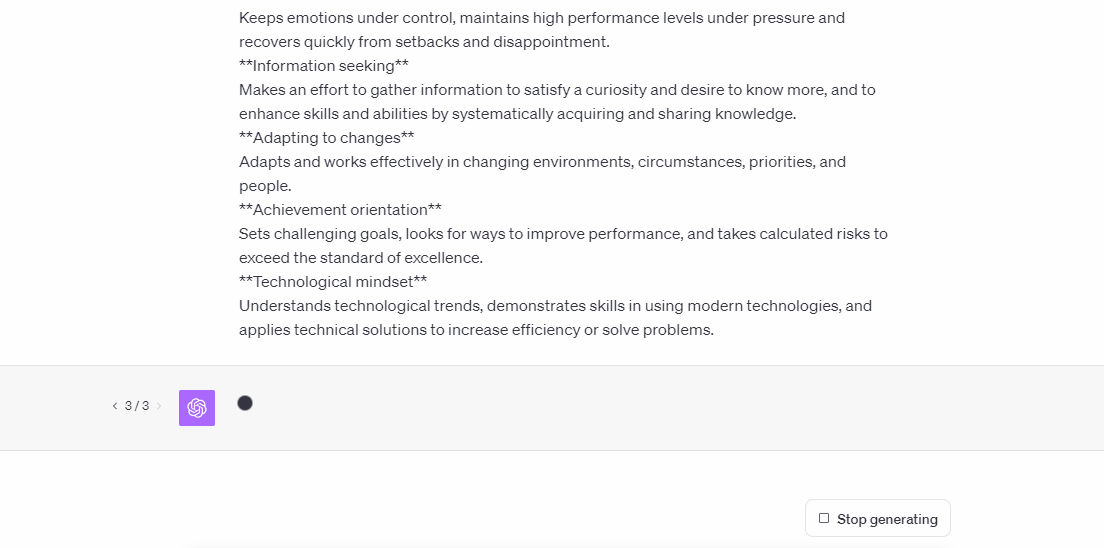
Key Objectives
The first step is to instruct ChatGPT to come up with the key objectives of the position. Key objectives are a description of the objectives a candidate should accomplish to be considered successful.
For example: Deals are moved through each sales pipeline stage following a consistent and predictable process.
Key objectives is a critical part in using AI to write hiring scorecards. It’s the objectives that will determine the quality of the overall hiring scorecard. The better your input at this stage, the better the quality of the end result.
As input, you can use your meeting notes with the hiring manager, an article that talks about the position, PDFs, Word files, etc. The input needs to be good enough and clear enough for the AI to analyze and develop the needed objectives.
In the example prompt below, I am using an excellent online guide by a16z on how to hire a chief information officer as input for the rest of process.
The prompt:
Write detailed key objectives for a role I will give you. For context, key objectives help create the context around the role to further develop a hiring scorecard.
Here's all the information you need about the role:
<~POSITION INFORMATION GOES HERE~>
### Example #1:
**Key objectives:**
- The business has a strong team of VPs and marketing specialists in place in critical functional areas, who are top-of-class in their respective channels.
- Marketing has built strong working relationships with key functions that impact growth (product, sales, customer success).
- The business has a clear understanding of how marketing money is spent and how that impacts business growth.
- Marketing team has set up an agile test-and-learn infrastructure for new channels.
- The business has a clear strategy in place and understands how different budget scenarios will impact growth.
### Example #2
**Key objectives:**
- Critical elements of a professional sales process (pipeline stages, funnel metrics, activity goals) are clearly defined and followed by the sales team.
- A basic sales playbook is in place for key segments and is detailed enough to start onboarding and training BDRs.
- A sales plan and corresponding hiring plan are in place based on the growth objectives of the business.
- Personal sales results are consistently met, and the results of the Head of Sales are seen as a performance benchmark by sales team members.
- Team members receive sufficient coaching and guidance to achieve their activity and performance targets. Underperforming team members are held accountable.
- Clear KPIs are in place for the sales team and are systematically monitored to identify improvement areas.
___
Based on this information and your general knowledge about hiring and key objectives, write 5 - 7 key objectives in the style as showcased in the examples.
The examples part in the prompt is there for guidance on how I want the AI to structure it’s answer and the writing style I want it to follow. If these do not match with what you’re looking for, modify the examples to match the style that you are after.
Position Requirements
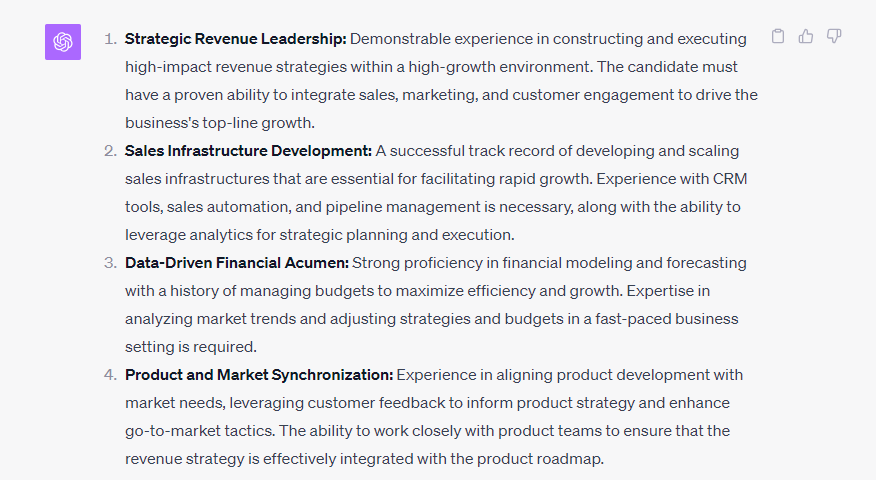
With the next prompt, I’m telling ChatGPT to use the above key objectives to write position requirements that are needed to fulfill the objectives.
Position requirements are the experiences and qualifications needed to accomplish the key objectives. For example: Sales Process Discipline - Demonstrated ability to methodically move deals through the sales pipeline using a CRM, adhering to a structured and repeatable process.
As with key objectives, the examples in the prompt are there to inform the AI about the format and style I’m after.
The prompt:
Taking all the above information into account, could you write 5-7 position requirements that are needed to fulfil the above-mentioned key objectives of this role? For reference, position requirements include the required experiences, qualifications, and skills needed to achieve the key objectives of the role.
Exclude educational requirements. Be descriptive with the requirements.
___
### Examples:
**Leadership in Sales and Revenue:** Proven track record in leading, scaling, and optimizing sales organizations, preferably in the SaaS industry.
**Cross-Functional Collaboration:** Ability to align and collaborate with marketing, sales, and customer success teams towards common revenue goals.
Competencies
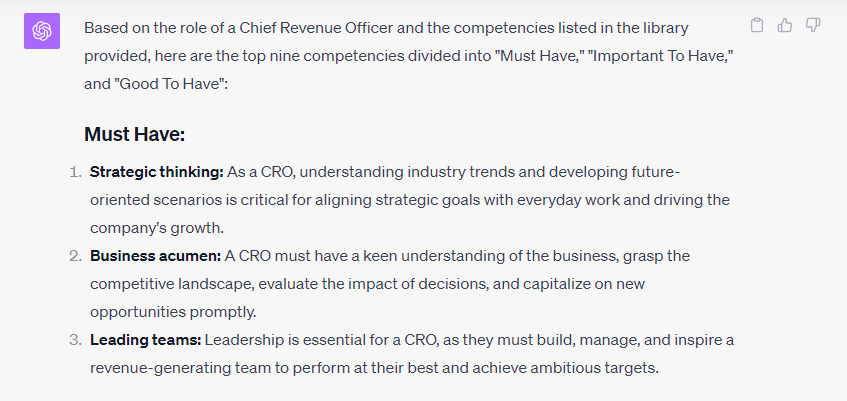
Competencies are the knowledge, skills, and abilities required to perform the job successfully. For example: Planning and organising - Effectively plans, coordinates, and prioritises work for oneself and others. Manages time and other resources to maximise productivity, ensuring tasks are completed successfully.
The prompt for competencies is long because I’m instructing the AI to use a specific Wisnio-developed competency library that I’ve included in the prompt.
Alternatively, you can use your own or let the AI choose the competencies for you. It’s knowledgeable enough that it will come up with the competencies on its own. The problem is you have no control over which library it uses or if it just makes them up.
The prompt:
Great, Thanks. Next, use the competency library I will provide you to choose the top 9 competencies that would be needed for this position. Divide the competencies into three groups - Must Have, Important To Have, and Good To Have. 3 competencies per group. Include the group titles in your answer.
# The competency library:
**Organizational awareness**
Understands and can work effectively with complex power dynamics, policy, and processes in organizations and with stakeholders.
**Conceptual thinking**
Identifies underlying issues, puts pieces together to see the big picture, and applies conceptual reasoning to come up with new ideas and unique responses to problems.
**Strategic thinking**
Understands industry trends, develops future-oriented scenarios, articulates a compelling vision, and links strategic goals to daily work.
**Analytical thinking**
Understands a complex and ambiguous problem by breaking it apart into smaller pieces, analyzes information in a logical and methodical manner.
**Business acumen**
Understands the business and the competitive situation, evaluates the impact of business decisions, and is quick to take advantage of new business opportunities.
**Planning and organizing**
Plans and prioritizes work for self and others, manages time and resources to maximize productivity, and ensures that work is completed efficiently.
**Ensuring accountability**
Provides direction confidently, communicates performance expectations, insists on high performance, and holds people accountable.
**Customer focus**
Desires to help or serve others, discovers the needs of clients or internal end-users, and takes action with the customer in mind.
**Attention to detail**
Monitors and checks work or manages information to reduce uncertainty in the surrounding environment, and is driven to ensure order, quality, and accuracy.
**Leading teams**
Demonstrates a desire to lead, takes on a role as a group leader, builds a strong team identity, and settles disputes without escalation.
**Developing others**
Encourages professional and personal growth, plans and uses effective developmental activities, and supports others to meet organizational or career goals.
**Building relationships**
Develops and maintains friendly relationships and builds networks that help achieve current or future professional goals.
**Influencing others**
Inspires, influences or impresses people in an honest and respectful manner to gain support and commitment, or to have a specific impact on others.
**Teamwork and collaboration**
Shows a genuine intention to be part of a team and works cooperatively with others towards collective goals and results.
**Interpersonal understanding**
Understands the unspoken or partly expressed feelings, goals, and needs of others, and can relate to culturally diverse groups of people.
**Resilience**
Keeps emotions under control, maintains high performance levels under pressure and recovers quickly from setbacks and disappointment.
**Information seeking**
Makes an effort to gather information to satisfy a curiosity and desire to know more, and to enhance skills and abilities by systematically acquiring and sharing knowledge.
**Adapting to changes**
Adapts and works effectively in changing environments, circumstances, priorities, and people.
**Achievement orientation**
Sets challenging goals, looks for ways to improve performance, and takes calculated risks to exceed the standard of excellence.
**Technological mindset**
Understands technological trends, demonstrates skills in using modern technologies, and applies technical solutions to increase efficiency or solve problems.
Behavioural interview questions
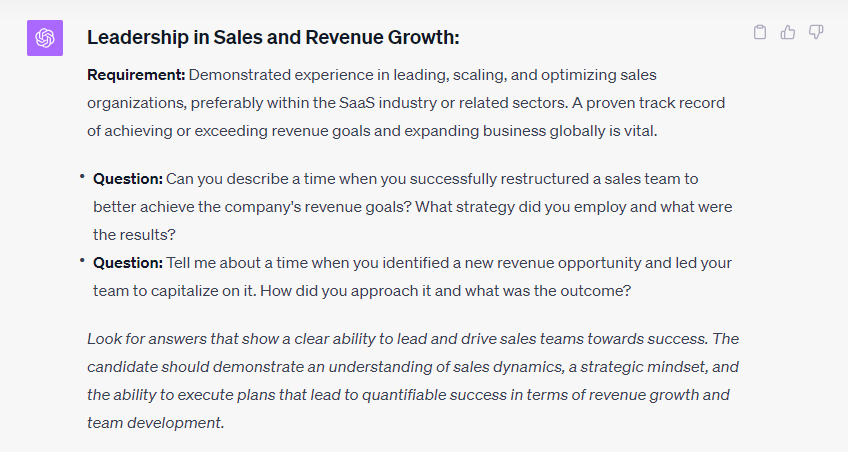
In this step, the AI will use the key objectives, position requirements, and competencies of the position to come up with competency-based behavioural interviewing questions.
As before, the prompt includes examples on how I want the AI to format its answer. In this case, I’ve instructed it to map the interview questions to the position requirements and to include pointers on what to look for in an answer.
The prompt:
Taking into account the key objectives, position requirements, and competencies of the role, what are the possible interview questions to evaluate a candidate for the described role?
Focus on competency-based behavioural interviewing questions. Map the questions to the above-mentioned position requirements. Include the requirement and the corresponding question(s) under each. Also include what I should be looking for in the answer.
Use the following format:
**Leadership in Sales and Revenue Growth:** Demonstrated experience in leading, scaling, and optimizing sales organizations, preferably within the SaaS industry or related sectors. A proven track record of achieving or exceeding revenue goals and expanding business globally is vital.
- Can you describe a time when you scaled a sales organization to meet an ambitious revenue goal?
- Tell me about a time when you led a sales team through a significant period of growth, such as international expansion.
*Look for specific examples where the candidate demonstrated strong leadership skills in managing and scaling a sales team. They should be able to articulate their strategies for growth, how they managed challenges, and the outcomes, especially related to achieving or exceeding revenue goals and expanding globally.*
---
**Leadership in Sales and Revenue Growth:** Demonstrated experience in leading, scaling, and optimizing sales organizations, preferably within the SaaS industry or related sectors. A proven track record of achieving or exceeding revenue goals and expanding business globally is vital.
- Can you describe a time when you scaled a sales organization to meet an ambitious revenue goal?
- Tell me about a time when you led a sales team through a significant period of growth, such as international expansion.
*Look for specific examples where the candidate demonstrated strong leadership skills in managing and scaling a sales team. They should be able to articulate their strategies for growth, how they managed challenges, and the outcomes, especially related to achieving or exceeding revenue goals and expanding globally.*
Writing the intro
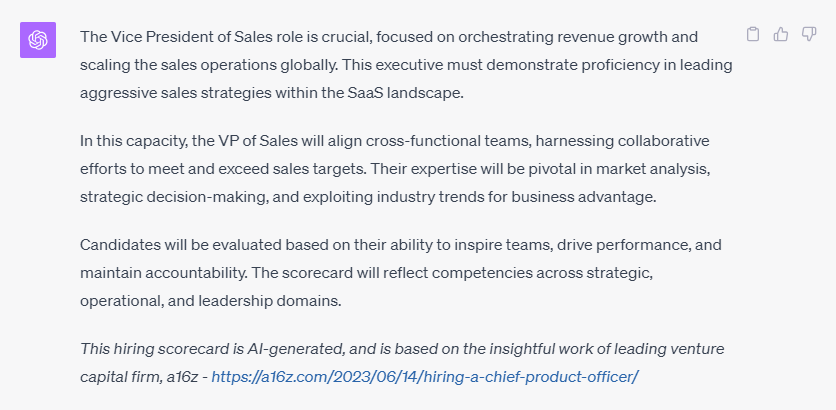
The last prompt is for writing an intro for the scorecard. Here, I’ve instructed the AI to use all of its knowledge about the position and write a 99 word intro. Additionally, I’m telling it to break the texts into three paragraphs and as before, I’ve included an example.
The prompt:
Based on everything you know about the role, write a 99 word intro for this hiring scorecard. Mention the name of the position and give an overview of what it’is all about. Break the text into three paragraphs of roughly 33 words each. Thank you.
## Example:
The Chief Product Officer (CPO) is a pivotal role in the organization, responsible for driving product strategy and execution. This role requires a visionary leader who can balance existing revenue streams with new product development.
The CPO will lead the transition from a single product to multiple product lines, craft strategic roadmaps, and spearhead market expansion. They will also unify the end-to-end customer experience and bridge the gap between sales and engineering.
The ideal candidate will have a proven track record in translating customer feedback into actionable insights, setting the vision for product strategy, and creating new opportunities for the company.
And that’s it. You now have a hiring scorecard with key objectives, position requirements, competencies + interview questions along with what to look for in candidate answers.
For an example of how a completed hiring scorecard looks like, click here -> https://www.wisnio.com/scorecards
Conclusions
The steps provided in this article offer a clear pathway to taking advantage of the potential of AI, from formulating the initial key objectives to coming up with comprehensive position requirements and identifying vital competencies.
It is essential, however, to remember that the quality of AI-generated content is largely dependent on the input it receives. Thus, while AI significantly streamlines the creation of hiring scorecards, the human element remains indispensable in guiding and refining the outcome to suit specific organisational needs.